
A Sense of Doubt blog post #3348 - Meshes of the Afternoon - by Maya Deren
There's repetition here on my blog.
For instance, I am an avid and regular reader of author Warren Ellis' newsletter.
From his April 14th 2024 edition of ORBITAL OPERATIONS:
 Every now and then, I go back to Maya Deren and Sasha Hackenschmied’s MESHES OF THE AFTERNOON. I have it on a DVD from Mystic Fire Video, but originally it was silent, and it’s on YouTube.
Every now and then, I go back to Maya Deren and Sasha Hackenschmied’s MESHES OF THE AFTERNOON. I have it on a DVD from Mystic Fire Video, but originally it was silent, and it’s on YouTube.I had seen Meshes of the Afternoon many years ago in my college film class but possibly not since or not more than once or twice.
It's on YOU TUBE??
I figured it was time to feature this on my blog along with some analysis found online.
FROM WIKI:
Meshes of the Afternoon
Sigmund Freud and Carl Jung[edit]
Viewers[who?] have attempted to decode the symbolism in the film from a Freudian or Jungian point of view to uncover possible messages about identity and sexuality. Deren adamantly objected to those who saw her film as symbolic; for her, the objects in the film were just that, objects "whose value and meaning is defined and confirmed by their actual function in the context of the film as a whole".[citation needed] Deren wanted her audiences to appreciate the art for its conscious value and spent much of her later career delivering lectures and writing essays on her film theory.[2]
FROM MOMA -
https://dianamarin.com/2019/12/19/meshes-of-the-afternoon-1943-spiralling-nightmare-maya-deren-dialogue-with-the-unconscious/
Analysis: Meshes of the Afternoon (1943): a spiralling lucid nightmare, Maya Deren, & A dialogue with the Unconscious
 Meshes of the Afternoon (1943) is a memorable, experimental, surreal short film directed and written by Maya Deren. Referred to as poetic psychodrama, the film was ahead of its time with its focus on depicting fragments of the unconscious mind, externalising disjointed mental processes, dreams, and potential drama through poetic cinematic re-enactments brought to life by uncanny doppelganger figures. The enigmatic protagonist, played by Deren herself, enters a dream world in which she finds herself returning to the same spots and actions in and around her house, chasing a strange mirror-faced figure in a nightmarish, entangling, spiralling narrative. Whilst she ritualistically goes through nearly identical motions, with some slight changes, within a domestic space that is imbued with dread and a sense of doom, unreality, and foreignness – we also witness glimpses of multiple versions of herself, watching herself. The camera shifts from subjective to objective angles as the self-representation of the protagonist alternates between the dichotomous concepts of the self and the “other”. The domestic space revolves around certain recurrent symbolic objects. The film conjures up the uncanniness of dissociation or, more specifically, depersonalisation; self-obsession, a woman’s dual inner/outer life and subjective experience of the world, all congruous with Deren’s interest in self-transformation, interior states, surpassing the confines of personality and self-construct, as well as the self-transcending rituals of Haitian Vodou. The dream story, culminating in death, symbolically alludes to the -sometimes strange and terrifying- initial, non-rational stage of the Jungian process of the “transcendent function” (the symbolic confrontation with the unconscious) leading to the separation of awareness from unconscious thought patterns and the liberating reconciliation between the two opposites: ego and the unconscious, which also has the effect of integrating neurotic dissociations.
Meshes of the Afternoon (1943) is a memorable, experimental, surreal short film directed and written by Maya Deren. Referred to as poetic psychodrama, the film was ahead of its time with its focus on depicting fragments of the unconscious mind, externalising disjointed mental processes, dreams, and potential drama through poetic cinematic re-enactments brought to life by uncanny doppelganger figures. The enigmatic protagonist, played by Deren herself, enters a dream world in which she finds herself returning to the same spots and actions in and around her house, chasing a strange mirror-faced figure in a nightmarish, entangling, spiralling narrative. Whilst she ritualistically goes through nearly identical motions, with some slight changes, within a domestic space that is imbued with dread and a sense of doom, unreality, and foreignness – we also witness glimpses of multiple versions of herself, watching herself. The camera shifts from subjective to objective angles as the self-representation of the protagonist alternates between the dichotomous concepts of the self and the “other”. The domestic space revolves around certain recurrent symbolic objects. The film conjures up the uncanniness of dissociation or, more specifically, depersonalisation; self-obsession, a woman’s dual inner/outer life and subjective experience of the world, all congruous with Deren’s interest in self-transformation, interior states, surpassing the confines of personality and self-construct, as well as the self-transcending rituals of Haitian Vodou. The dream story, culminating in death, symbolically alludes to the -sometimes strange and terrifying- initial, non-rational stage of the Jungian process of the “transcendent function” (the symbolic confrontation with the unconscious) leading to the separation of awareness from unconscious thought patterns and the liberating reconciliation between the two opposites: ego and the unconscious, which also has the effect of integrating neurotic dissociations.
Continuity is absent in the disjointed dream narrative of the film. The woman goes up the stairs inside the house and unpredictably emerges from the window in a haunting shot, wrapped in and caressed by soft, semi-transparent curtains. After catching her 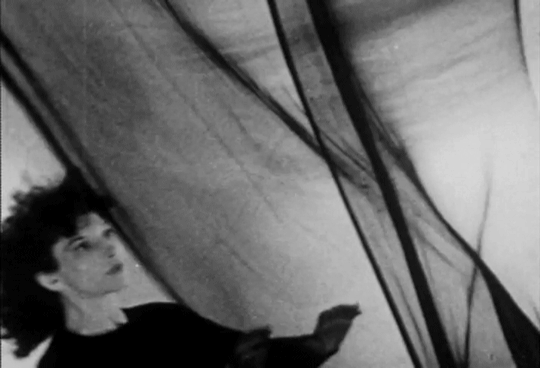 distorted reflection in the polished knife, the camera follows her fluid bending movements as she is crawling on the staircase, whilst being strangely blown away by the wind in various directions within a claustrophobic space, levitating, trying to hang onto things, and eventually hanging in a crucified position against the wall. With her bat-like presence casting a larger-than-life shadow behind her, she gazes at her sleeping body on the couch through a point-of-view shot from the ceiling. This moment vividly evokes the concept of an out-of-body experience. She then watches a previous version of herself through the window, following the flower-holding, black cloaked figure outside. Unable to catch up, she enters the house, and the subjective camera movement switches to this version of her, whilst she catches a glimpse of the funereally dark, cloaked apparition walking up the stairs.
distorted reflection in the polished knife, the camera follows her fluid bending movements as she is crawling on the staircase, whilst being strangely blown away by the wind in various directions within a claustrophobic space, levitating, trying to hang onto things, and eventually hanging in a crucified position against the wall. With her bat-like presence casting a larger-than-life shadow behind her, she gazes at her sleeping body on the couch through a point-of-view shot from the ceiling. This moment vividly evokes the concept of an out-of-body experience. She then watches a previous version of herself through the window, following the flower-holding, black cloaked figure outside. Unable to catch up, she enters the house, and the subjective camera movement switches to this version of her, whilst she catches a glimpse of the funereally dark, cloaked apparition walking up the stairs.
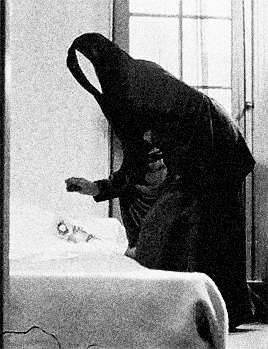 The elusive mirror-faced character is compelling and symbolically evocative. Nun, Grim Reaper, or mourner? The hooded black cloak and the ritual of bringing a flower to someone’s bed are immediately reminiscent of death, of mourning, and associations between bed/tomb and sleep/death. As the face of the obscure ghost-like manifestation is actually a mirror showing the reflection of the watcher, the scenario conjures up the idea of mourning one’s own death. After leaving the flower on the bed, the character disappears and the image of the woman also disappears and re-materialises several times, back and forth on the staircase. She then heads towards her own sleeping body whilst holding a knife, proceeding to try to stab herself before she awakens and sees a man holding a flower in front of her.
The elusive mirror-faced character is compelling and symbolically evocative. Nun, Grim Reaper, or mourner? The hooded black cloak and the ritual of bringing a flower to someone’s bed are immediately reminiscent of death, of mourning, and associations between bed/tomb and sleep/death. As the face of the obscure ghost-like manifestation is actually a mirror showing the reflection of the watcher, the scenario conjures up the idea of mourning one’s own death. After leaving the flower on the bed, the character disappears and the image of the woman also disappears and re-materialises several times, back and forth on the staircase. She then heads towards her own sleeping body whilst holding a knife, proceeding to try to stab herself before she awakens and sees a man holding a flower in front of her.
The phantom steps of the hooded dream character are traced and re-traced by the man and the woman in what appears to be reality but turns out to be a dream within a dream. The man carries the flower upstairs, leaving it on the bed, a gesture that echoes the dream act but is seen in a different context- of intimacy rather than a religious or funereal act.  The flower, a symbol of femininity, is therefore connected with death and sexuality, respectively. After a shot of the reflection of the man in the mirror next to the bed, we watch her lying down through the male gaze. The camera switches to the predatory look on his face, and, as he is about to touch her, she grabs the knife and tries to stab his face. At this point, the knife breaks a mirror instead, and the face of the man disintegrates into shards (another connection between the man and the dream figure), revealing an image -perhaps a memory- of waves and the beach. The man comes inside the house again to find the dead body of the woman on the couch- she committed suicide by cutting herself with a mirror.
The flower, a symbol of femininity, is therefore connected with death and sexuality, respectively. After a shot of the reflection of the man in the mirror next to the bed, we watch her lying down through the male gaze. The camera switches to the predatory look on his face, and, as he is about to touch her, she grabs the knife and tries to stab his face. At this point, the knife breaks a mirror instead, and the face of the man disintegrates into shards (another connection between the man and the dream figure), revealing an image -perhaps a memory- of waves and the beach. The man comes inside the house again to find the dead body of the woman on the couch- she committed suicide by cutting herself with a mirror.
Deren poetically described the moment of the intertwining worlds as “a crack letting the light of another world gleam through.” [Deren, “A Letter”, in Essential Deren]
The uncanny dimension of the film lies in the transformation of the familiar environment into something mystifying, the dream-reality ambiguity, the repetition compulsion, the doubling (tripling and quadrupling), the distortions in spatial and temporal awareness, as well as the repetitive use of familiar images such as household objects that seemingly gain unknown symbolic connotations, whilst functioning as mnemonic devices. The juxtaposition of objects also contributes to the sense of dread and paranoia- the off-the-hook phone, the silent record player, the flower left behind by the enigmatic figure, the knife, the falling key. We can associate the off-the-hook phone with loss of communication, the knife -phallic form, therefore masculinity, besides the surface level connection with danger and death, the flower, as mentioned, having a contrasting effect-femininity, but also, death in this context; the key represents confinement, repression, and feeling entrapped, but also the possibility to escape. When the woman pulls out the key from her mouth, perhaps she had “the key” to find the way out all along, and then, as the regurgitated key turns into a knife, there is a connection between escape and (psychic) suicide. The mirror stands for introspection, and the death by mirror cut might allegorically refer to the disintegration of the identity construct, linked to liberation. When a version of the woman picks up the knife, she is re-claiming her agency, wielding phallic power.
It is worth mentioning that the director strongly opposed and discouraged psychoanalytic interpretations of her film and of the symbolic significance of the objects the film revolves around, instead encouraging the viewer to only interpret them in the context of the film narrative as a whole to avoid going beyond conscious intent in art. This brings me back to an inner debate on the topic of film analysis, its limitations and the question whether there is such a thing as going “too deep” into conscious and unconscious meaning behind film. The “risk” of going too deep is ingrained in the nature of the work of any film scholar or critic, especially when it comes to cine-psychoanalysis. However, when it comes to surreal films in particular, the intentions are blurred and open to interpretation, and clearly Deren’s art is lyrical in its symbolic nature, created by association of poetic images, and influenced by her interest in psychology. Before turning to cinematography, Maya Deren expressed herself through poetry, but she found it too limiting to convey the images in her mind through words.
To respect the wishes of the creator, let’s also look at her own statements related to the film, as well as her general preoccupations and beliefs, which are transparently relevant to the film.
“This film is concerned with the interior experiences of an individual. It does not record an event which could be witnessed by other persons. Rather, it reproduces the way in which the subconscious of an individual will develop, interpret and elaborate an apparently simple and casual incident into a critical emotional experience.” —Maya Deren on Meshes of the Afternoon, from DVD release Maya Deren: Experimental Films 1943–58.
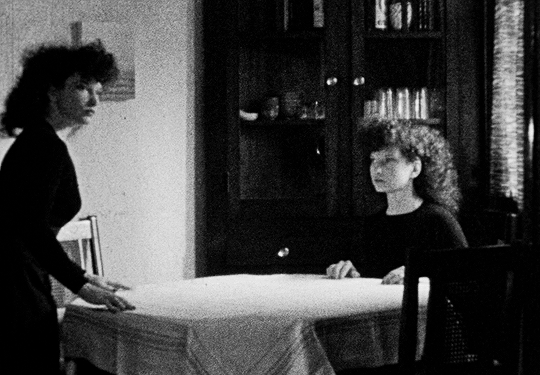 The multiplying of the character is connected to dissociation, alienation, emotional fragmentation, and potentially reintegration towards the end. The multiple incarnations of the woman evoke an internal schizoid narrative breathing life into alternative versions of herself- challenging her self-construct. Some of her personas are passively observing her more powerful, key-holding, knife-wielding persona. The suicide is symbolic, despite the fact that, in the final scene, it appears as if the layers of the dream world are peeled off and we have access to the real world. I believe the death symbolism is derived from Jungian psychology- i.e. the death and resurrection of consciousness. In light of this thought, the film can represent a visual representation of Jung’s Transcendent Function. What unfolds on screen is the process through which a person gains awareness of and confronts unconscious material driving their life in order to unite and re-channel the opposing energies of the ego and the unconscious into a third state of being, of wholeness. This would also have an integral effect that will merge the embodiments of the character’s dissociations. According to Jung, the process involves a challenging, unnerving unleashing of fantasies, dreams, and instincts. The sense of dread and panic evoked by the film matches this idea. The process is also associated with the notion of ego death in Eastern philosophies.
The multiplying of the character is connected to dissociation, alienation, emotional fragmentation, and potentially reintegration towards the end. The multiple incarnations of the woman evoke an internal schizoid narrative breathing life into alternative versions of herself- challenging her self-construct. Some of her personas are passively observing her more powerful, key-holding, knife-wielding persona. The suicide is symbolic, despite the fact that, in the final scene, it appears as if the layers of the dream world are peeled off and we have access to the real world. I believe the death symbolism is derived from Jungian psychology- i.e. the death and resurrection of consciousness. In light of this thought, the film can represent a visual representation of Jung’s Transcendent Function. What unfolds on screen is the process through which a person gains awareness of and confronts unconscious material driving their life in order to unite and re-channel the opposing energies of the ego and the unconscious into a third state of being, of wholeness. This would also have an integral effect that will merge the embodiments of the character’s dissociations. According to Jung, the process involves a challenging, unnerving unleashing of fantasies, dreams, and instincts. The sense of dread and panic evoked by the film matches this idea. The process is also associated with the notion of ego death in Eastern philosophies.
To further delve into Deren’s psyche and establish other links, let’s remember that she was fascinated by the rituals of Haitian Vodou and religious possession. She later participated in Vodou ceremonies and documented the rituals. Together with her love of dance (and later, her experience with recreational drugs) her immersion in and fascination with rituals were also a result of seeking to drift away from self-centredness, to go beyond self-construct and personality, and merge with something greater. This is again related to the Buddhist concept of ego death – a transcendent, life-turning mental state with self-revelatory consequences. We know that Deren has a preoccupation with the transformation of the self and reaching higher spiritual states of awareness. In this excerpt from An Anagram of Ideas on Art, Form, and Film (1946), she makes insightful comments about ritual:
“The ritualistic form treats the human being not as the source of the dramatic action, but as a somewhat depersonalised element in a dramatic whole. The intent of such depersonalisation is not the destruction of the individual; on the contrary, it enlarges him beyond the personal dimension and frees him from the specialisations and confines of personality. He becomes part of a dynamic whole which, like all such creative relationships, in turn, endow its parts with a measure of its larger meaning.”
I am glad she mentions depersonalisation and associates it with a form of spiritual awakening, as this coincides with my beliefs on depersonalisation and derealisation, which are also relevant to the film. The two often go hand in hand. Both experiences (note I’m not referring to them as ‘disorders’) involve a feeling of detachment – from one’s thoughts and from reality, as well as an awareness of this detachment (which distinguishes it from psychosis: there are no delusions or psychotic elements involved). Derealisation involves experiencing the world as if you are living in a dream or a film, and depersonalisation is the feeling of unreality of the self, which has been introduced as a psychiatric disorder of the dissociative type in 1930 and has been updated and re-interpreted several times in various psychiatric diagnosis manuals. Other common features mentioned in the DSM-IV are an uncanny distortion in visual and temporal perception, a feeling that other people, places, or events appear unfamiliar, unreal, or mechanical and lacking emotional depth. An individual experiencing this might feel like an outside observer of his or her own mental processes. All of this also applies to Meshes of the Afternoon where the protagonist is in a perpetual, adrift state of trance as she navigates the dream web and observes herself from an external perspective, whilst familiar objects appear foreign, strange, or ‘tainted’.
Here is an excerpt from Feeling Unreal, one of the few books tackling the elusive topic of DPD- written by Daphne Simeon, MD and Jeffrey Abugel. The description matches the insight and feeling revealed by Deren regarding the state of depersonalisation in ritual:
“No longer grounded by familiar sensations or surroundings, they feel as if they’re losing their grip on reality. But unlike people with psychotic conditions like schizophrenia, they are not going insane at all. They are, if anything, suddenly overly aware of reality and existence and of the ways in which their own experience is a distortion of a ‘normal’ sense of a real self. Depersonalisation, in fact, resembles a sort of altered ‘awareness’ or ‘awakening’ that in some cultures is thought to be a level of spiritual growth.”
It is worth watching both existing versions of the film: Your viewing experience might change depending on whether you watch the early silent version or the 1959 version accompanied by the official sombre, atmospheric soundtrack created by Teiji Ito, Maya’s second husband. You will also not be surprised to find out that the dreamlike atmosphere and narrative of Meshes was a source of inspiration for David Lynch’s Lost Highway (1997) and Mulholland Drive (2001).
https://www.thecine-files.com/teaching-meshes-of-the-afternoon/
TEACHING MESHES OF THE AFTERNOON
Sarah Keller
Perhaps unfairly, I think of Maya Deren’s Meshes of the Afternoon (1943) as the center of a wheel with many spokes on a conveyance that takes a body just about any worthwhile place it might wish to travel. I don’t expect every student to be transported by it, but I do try to highlight the many worthwhile stops along the course it runs. Usually I teach it in undergraduate classes where, more often than not, students have had very limited if any exposure to experimental films—or films by women, for that matter—or black-and-white films from any year before the new millennium, or etc., etc., etc. So that’s the potentially unfair part of it: the film has to carry the freight of representing a good deal of film history that the students might otherwise miss. But as I said, this wheel has many sturdy spokes and travels far.
Before the class begins to examine the spokes radiating out from Meshes of the Afternoon’s center, I find it important to anticipate a principal objection that gets raised when I show experimental films of any kind in an introductory film course. It takes a few different forms, but generally involves skepticism. This reaction has to do with a student’s fear that the film is difficult or willfully (and confusingly) mysterious and that they just don’t and won’t get it—that it has a single, clear meaning that is hidden from them and they risk sounding stupid if they talk about it. Frequently, doubts about the value of non-linear, non-causal, non-narrative forms accompany this response. The question, to put it plainly, is something like: “what’s the point of a film like this?”
So keeping in mind that this will come up or is somewhere hovering over the class as we watch the film together, I begin by asking how we might start to engage with this film, and why should we engage with it. Where ought one to begin in a film where beginnings and ends are indefinite? To answer these questions, we start to examine some of the spokes more closely.
We might start with just a few brief statements of fact:
Meshes of the Afternoon was made in 1943 for a few hundred dollars (about $275) in the first months of Maya Deren’s marriage to already accomplished filmmaker Alexander Hammid. It was originally silent, but Deren added a soundtrack to it in 1959. Immediately after making it, Deren drafted an essay entitled “Cinema as an Art Form,” in which she addressed what she had been trying to achieve in this, her first film, and in her film practice more generally.
The implications of these few facts are far-reaching:
First, they signal an amateur (Deren liked this word to describe an aspect of her work because of its etymological relation to a lover) and a do-it-yourself aesthetic. This provenance puts the film into the realm of cinema outside of commercial/narrative interests on the one hand and strictly documentary/social/political interests on the other. Deren talks about this issue in “Cinema as an Art Form,” an essay I like to assign with Meshes of the Afternoon (a pairing representing an early foray into filmmaking and writing about film).[1] Having this point of reference serves as a touch point for aspiring filmmakers in the class: it serves as encouragement for thinking of cinema as something any inspired soul might take up. It also initiates a sense of film history as subject to a range of influences outside of the mainstream.
Second, these few facts underline the notion of cinema both as a singular creative act by a visionary artist and, simultaneously, as a collaborative process. Deren consistently credited the creative labor of her collaborators as part of her films’ provenance, and Meshes of the Afternoon rightly acknowledges Hammid’s part. This recognition offers an intervention in the history of cinema shaped by auteurist approaches, to allow the influence of multiple personnel in filmmaking. Hammid plays a considerable role here, as does Teiji Ito, whose score was added about fifteen years after Meshes of the Afternoon was finished. This emphasis on collaboration diminishes the perception that the director is the singular helmsperson for a film project. At the same time, the small number of persons working on the film points to the possibility of controlling the outcome of a film made as a work of art rather than as a commercial product with many producers whose thumbs are in the creative pie. Deren and Hammid wrote, directed, acted in, and filmed it together, without recourse to studio concerns. Meshes of the Afternoon underlines the collaborative nature of film production, but in an experimental context, where interestingly the need for collaboration and cooperation is diminished.
Third, this short set of facts about the film offers an insight into the unusual feminist dynamics of the film. Meshes of the Afternoon has sometimes been (rather perversely) described as Deren and Hammid’s honeymoon home movie. For her whole working life, Deren struggled against the norms of a male dominated industry and art form. Does the relationship between the woman in the film (played by Deren) and the man in the film (played by Hammid) reflect her vocational difficulties?[2]
Fourth, the year the film was made points to a number of ways we might contextualize Meshes of the Afternoon in film history and in history more broadly. At a minimum, I try to connect it to film noir, women’s films, and art movements of the moment. I usually show still images or short clips to illustrate the stylistic connections among these forms. Or I contextualize the film and its mid-war context by considering what, in terms of its historical moment, it is not. For instance, I sometimes show the number “The Lady in the Tutti Frutti Hat” from The Gang’s All Here (which was made the same year, 1943) to launch a study in contrasts and to show the cinematic intervention Deren is making in her moment. Deren once wisecracked that she spent on her films what Hollywood spent on lipstick: in The Gang’s All Here, I’m pretty sure the lipstick budget (and the prop budget: cf. bananas) must be significantly higher than Deren’s whole film. The contrast inspires discussions about gender dynamics, production values, and political investments.
Fifth, the change from silent to sound in the film’s own history underscores Deren’s working method and perspective on her process. In short, she felt that her work was perpetually ongoing—quoting poet Paul Valéry on this matter, she described her films as “never completed, but merely abandoned.”[3] The way she revisited Meshes of the Afternoon and transformed it from silent to sound illustrates her thinking about the open-ended nature of film form and creative labor.
And finally, as I mentioned, I like to assign “Cinema as an Art Form” with the film because it was written so soon after Deren and Hammid made Meshes of the Afternoon and therefore encapsulates a lot of the ideas she was working through in the film. The issues she raises here both illustrate the ideas afoot in the film and galvanize her thinking for future projects. This pairing represents the marriage of film production and film theory in miniature, and therefore serves as an excellent way to introduce a practical value and application for theory. We talk about it in terms of how Meshes of the Afternoon might be engaging these issues specifically:
- What can film do as an art?
- What is the role of reality in a creative film project?
- Why does Deren emphasize the film experience? What experience do you find encapsulated by Meshes of the Afternoon?
While we discuss these issues, I periodically draw attention to a key passage or two to ground our observations in the text itself. (For instance: “When we agree that a work of art is, first of all, creative, we actually mean that it creates a reality and itself constitutes an experience.”[4])
While Meshes of the Afternoon affords a robust introduction to this set of key issues for cinema studies more generally, what really works on the handful of converts to experimental cinema that it inspires is the film itself. The film apportions a range of access points for its viewers: it embraces circularity and repetition (in its overall structure), assays the expressive capacities of the camera (especially movement: for example in the sequence repeated with variations of Deren ascending the interior staircase), and mobilizes post-production techniques to effect a fantasy of multiplying subjects, bringing non-contiguous spaces together through the magic of editing (e.g., the famous steps taken across multiple spaces). While the non-continuity and alternative narrative structure present a challenge to a lot of students, if we start with simply what we’ve observed, and then try to come up with one other thing in the film that seems to relate to it in some way, it soon becomes a dynamic network of associations and ideas.
For example, we might start with the first images: an arm descends into the frame and deposits a flower on the sidewalk. We might notice that it is not a real arm (it helps to look at the clip or a still of it for anyone who missed it).[5] Then we try to think of other things that are not real (shadows, mirror-faced people, the flower, the status of the multiple women who assemble in the house, etc.). We make a list together of how these similar items relate to each other. We think about the associative properties of the objects and ideas that circulate in the film. Because this emphasis on association is one of the film’s strategies for the kinds of meanings it effects, we spend some time coming up with these mini-networks, drawing them as a cluster diagram with a central idea in the center so that we can start to group the ideas without limiting them to one trajectory. I like to have them do this in smaller groups and then share their diagrams by drawing them on the board so we can all see them, add to them, and argue for how the groupings should come together. Then we draw conclusions about what the film is saying about the relationship among these similar kinds of images and ideas.
On a personal note, I love teaching Meshes of the Afternoon. As much as I have thought about it, written about it, seen it, it still feels like it holds the mysterious energy of a genuine work of art (as Deren described it, there are points in the film where it is “like a crack letting the light of another world gleam through…”[6]). It yields new things every single time for me. The real danger for me in teaching it is that I feel I have many, many things to say and share about it. In fact, any time I teach a film I know very well, I have to put limits on what we cover and set a clear focus for the aims of whatever class I am teaching. Otherwise, I find myself getting off track with all the wonderful details in my long-gathered knowledge about the film’s intricacies and production circumstances. It is important to be mindful of consistently returning to the film itself, where the students might invest in their own viewing of the film and where they might find ready access to “the powerful potentialities of the imaginative experience.”[7]
Sarah Keller is Assistant Professor of Art and Cinema Studies at the University of Massachusetts-Boston. She co-edited the collection Jean Epstein: Critical Essays and New Translations (Amsterdam University Press, 2012), and her book Maya Deren: Incomplete Control (Columbia University Press, 2014) examines the role of unfinished cinematic works by focusing on Maya Deren’s oeuvre. Keller’s current project, Cinephilia/Cinephobia, focuses on the history and theory of love and anxiety in the cinema.
Notes
[1] Maya Deren, “Cinema as an Art Form,” in Essential Deren: Collected Writings on Film. Bruce McPherson, ed. (Kingston, NY: Documentext, 2005): 19-33.
[2] For just one example of Deren’s struggles, see the transcript of her participation in a symposium on poetry and film from 1953, in which poet Dylan Thomas and playwright Arthur Miller both make derisive, sexist jokes about Deren’s contributions to the discussion.
[3] Deren, Publicity materials. Maya Deren Collection, Boston University Mugar Library Special Collections.
[4] Deren, “Cinema as an Art Form,” 22.
[5] Jacqueline Stewart started a complex, highly rewarding discussion of Meshes of the Afternoon with this image in her Introduction to Cinema Studies class at the University of Chicago in 2007, for which I was one of the teaching assistants. I want both to give her credit for this as a workable access point into the film and to note that a lot of my teaching is indebted to the fabulous teachers I’ve encountered in my own education.
[6] Deren, “A Letter” (to James Card, 19 April 1955). In Essential Deren, 192.
[7] Deren, “Cinema as an Art Form,” 23.
The Cine-Files, issue 9 (fall 2015)
also:
+++++++++++++++++++++++++++++++++++++++++++++++++++++++++++++++++++++++
+++++++++++++++++++++++++++++++++++++++++++++++++++++++++++++++++++++++
+++++++++++++++++++++++++++++++++++++++++++++++++++++++++++++++++++++++
- Days ago = 3212 days ago
- New note - On 1807.06, I ceased daily transmission of my Hey Mom feature after three years of daily conversations. I plan to continue Hey Mom posts at least twice per week but will continue to post the days since ("Days Ago") count on my blog each day. The blog entry numbering in the title has changed to reflect total Sense of Doubt posts since I began the blog on 0705.04, which include Hey Mom posts, Daily Bowie posts, and Sense of Doubt posts. Hey Mom posts will still be numbered sequentially. New Hey Mom posts will use the same format as all the other Hey Mom posts; all other posts will feature this format seen here.
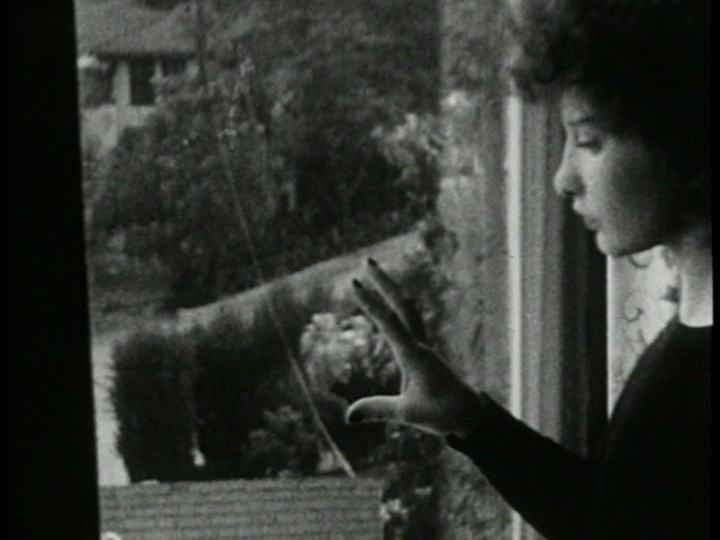
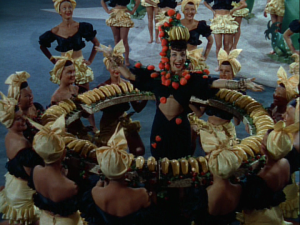
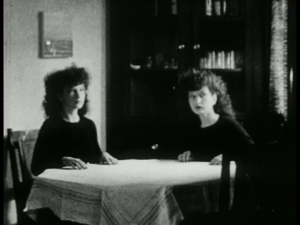
No comments:
Post a Comment